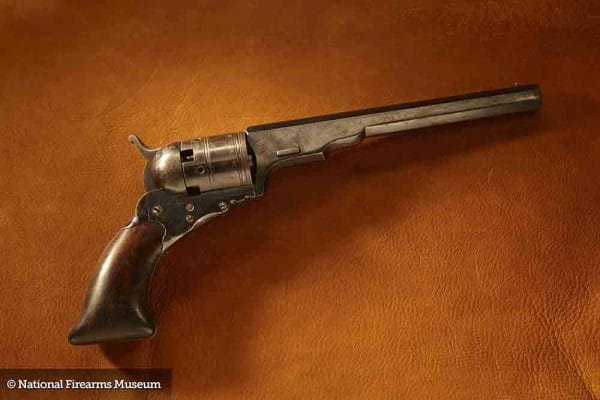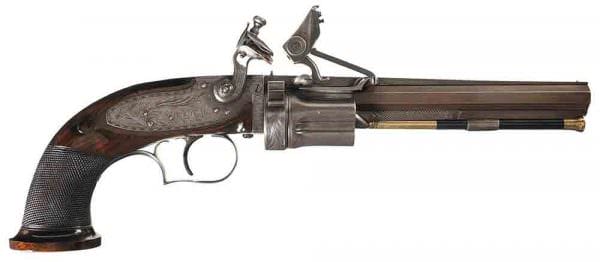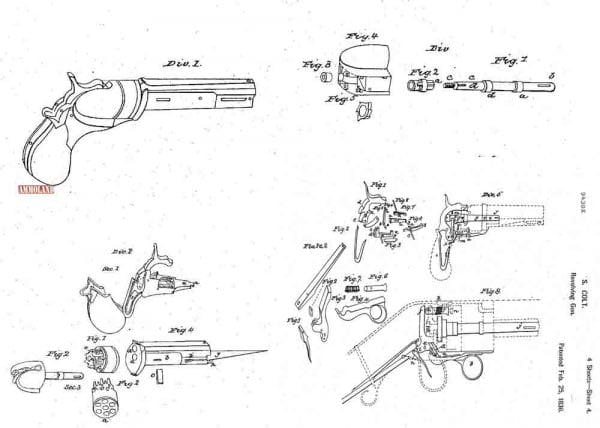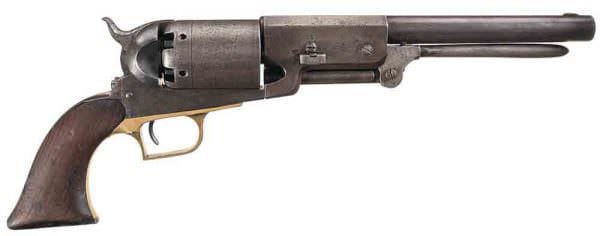U.S.A. –-(Ammoland.com)- On February 25, 1836, Samuel Colt received the U.S. patent for his design of a revolver. One of the most important innovations in the history of firearms was Samuel Colt’s designs for a revolving cylinder pistol.
After securing patent rights in both the United States and England, Colt established his manufacturing company in Paterson, New Jersey. Colt quickly began production of the first commercially available revolving pistol, the Colt Paterson. The revolver was patented by 1836 and first produced that same year by Colt’s Patent Firearms Manufacturing Company. Samuel Colt’s revolver design has continued to be one of the most popular firearm choices of all time and is still produced by Colt Manufacturing Company today.
Revolvers were the invention that started Samuel Colt’s success as an inventor, yet his designs owed heavily to another firearm developed by two less-known American inventors.

Among the most important predecessors to the Colt Paterson, was the Collier repeating flintlock pistol created by two American inventors, Artemus Wheeler and Elisha Collier. Wheeler and Collier worked together to create a repeating flintlock pistol and rifle. Their system was capable of reloading gunpowder automatically, it also had a cylinder that held five shots. The firearms required the user to cock the flint back and manually rotate the cylinder after each shot.
The two inventors applied for separate patents, Wheeler received his from the United States in 1818, and Collier from the British in the same year. In the end, Wheeler was unsuccessful in producing or selling these firearms in the American market. On the other side of the Atlantic, Elisha Collier was successful in selling his design to the British military, who deployed some of these weapons to their colonies in India.

Fast forward from 1818 to 1830, Samuel Colt is onboard a ship named the Corvo, on its way to India, and also made a stop in England. Five years later Colt would return to England in order to inspect Elisha Collier’s designs. While visiting these designs Colt applied for a British patent. British officials were hesitant to give Colt a patent because of the popularity, familiarity, and similarities between Collier and Colt’s designs. In October 1835, Colt received his patent from the British. By February 25, 1836, Colt owned patents in both Britain and the United States.
Within U.S. Patent No. 138 (or 9430X) Samuel Colt outlined specific advantages to his revolvers. Not including the number of charges the pistols contained, Colt wrote that the advantages were…
“First, the facility in loading them; Secondly, the outward security against dampness; thirdly, security of the lock against smoke and powder; fourthly, the use of the partitions between the caps (percussion cap ammunition), which prevent fire communicating from from the exploding cap to the adjoining ones; fifthly, by the hammer’s striking the cap at the end of the cylinder no jar is occasioned, deviating from the line of sight; sixthly, the weight and location of the cylinder, which give steadiness to the hand; seventhly, the great rapidity in the succession of discharges, which is effected merely by drawing back the hammer and pulling the trigger.“

All legal documents in order, Samuel Colt opened the Colt Patent Firearms Manufacturing Company out of Paterson, New Jersey in 1836. The company started production of their first revolving firearms, the Colt Paterson.
Although a revolutionary weapon, the Colt revolving firearms initially saw poor sales results and by 1842 was forced to close production. Samuel Colt had invested time and revenue into seeking clients and subsequently lost control of the company to board members. From those sales, Colt was able to sell the pistol to the Texas Rangers. In 1845 the pistol saw military action with Captain John Coffey Hays and twenty other rangers fighting off 80 Comanche warriors using the Colt Paterson.
It was not until 1847 and the introduction of Samuel Colt with another Texas Ranger, Sam Walker. Walker approached Colt about developing a larger caliber revolver capable of handling warfare in the West. The development of the Colt Walker would mark the start of the widespread commercial success of the revolver.

About Brian D. Johnson:
Brian Duncan Johnson is a graduate of George Mason University in Fairfax, Virginia. His focus of studies were on History and Government. Duncan is a regular contributor to AmmoLand and assists in the everyday gun-news publishing as an assistant editor.

“God created man but it was Sam Colt who made us equal.” Unknown from a Colt advertisement
Facinating insight into the Colt progression. Having driven past the huge Colt factory in Hartford, CT for many years, and visiting the Colt factory in W Hartford, I didn’t know that it started in Patterson NJ. What I’ve learned here is that I gotta do more exploring on this history. Thanx.
I know Jim Supica. I was on Gun Gurus #9. He is a real gentleman, and writes a pretty good book, too.